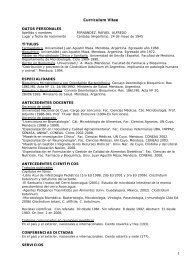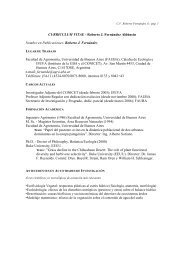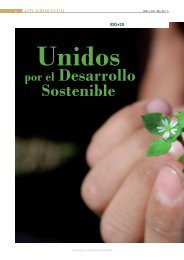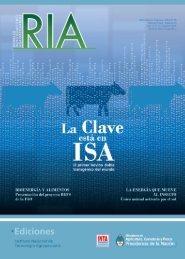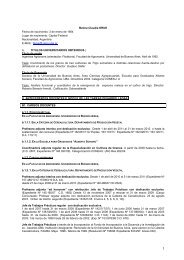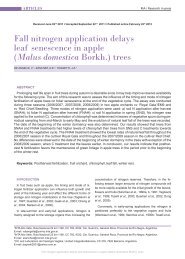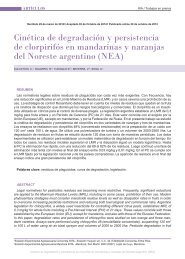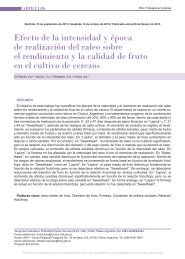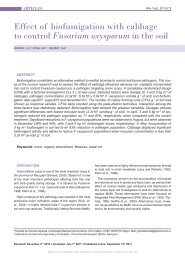Abril 2011, Arg<strong>en</strong>tina 55ABSTRACTThis study compares the use of a prototype diret drill for pasture r<strong>en</strong>ovation designed by this researchteam with a no tillage pasture r<strong>en</strong>ovation from a well-known trademark (control). The study was carried outin tall fescue (Festuca arundinacea Schreb.) sowings planted in the fall on brok<strong>en</strong> down alfalfa (Medicagosativa sp.) plains. The drill planting kit of the prototype has, a part from the circular fluted coulter, a set ofbeams with plantation hoes with small wing in its lower part. This hoe was first tried individually exhibiting agood performance. The experim<strong>en</strong>tal design was of divided plots including the prototype with a variant consistingof a drilling pasture r<strong>en</strong>ovation kit similar to the one available in the market, and also including it asthe control machine. All machines were used with and without fertilization at drilling.The aim of using the beam with plantation hoe with small blades in the tillage of the planting row is to improveseed bed preparation and to avoid surface packing due to cattle trampling and incorporating Phosphorto a higher depth (150 mm bellow the seed).In the three years of experim<strong>en</strong>tation, it was demonstrated that there were significant differ<strong>en</strong>ces in the effici<strong>en</strong>cyof implantation 30 days after planting in favor of the prototype with the plantation hoe with respect toboth machine available in the market and the prototype with planting rows similar to the one available in themarket. This is significant since the germination rate is fundam<strong>en</strong>tal if rainfall lacks after planting up untilspring, thus delaying germination and the first forage cutting. The same happ<strong>en</strong>ed 180 days after planting inthe year 2003, wh<strong>en</strong> there was no rainfall after planting and up until the <strong>en</strong>d of that year. In 2002 and 2004,however, the number of plants established in all the treatm<strong>en</strong>ts showed no significant differ<strong>en</strong>ces. This waspossibly due to early spring rainfalls.In forage production, there was higher production in the treatm<strong>en</strong>ts with the fertilization provided by theprototype with the plantation hoe and blades, compared to the other treatm<strong>en</strong>ts, however, not exhibiting significantdiffer<strong>en</strong>ces.There was less soil compaction, up to 120 mm deep (soil mecanical resistant under the planter tracks),with the new prototype than with the control machine.Summing up, the application of the prototype with a planting and fertilization kit with plantation hoe withsmall wing in the Rio Cuarto region could be a b<strong>en</strong>eficial application because it produces a higher germinationand crop implantation rate and less soil compaction compared to a diret drill for pasture r<strong>en</strong>ovation froma well-known trademark.Key words: drill planting kit, small hoe with wing.INTRODUCCIÓNEs importante destacar que <strong>en</strong> la revisión bibliográficase ha <strong>en</strong>contrado información muy escasa sobre laimplantación o intersiembra de pasturas con máquinasde siembra directa como los que se comparan <strong>en</strong> estetrabajo y m<strong>en</strong>os aún con el sistema de siembra y fertilizaciónsimilar al diseñado para el mismo, el cual se hayaincorporado a un prototipo cuyo peso, al trabajar portransfer<strong>en</strong>cia de éste, es sólo la mitad de una máquinasimilar de mercado para implantación de pasturas.Delafosse (1993), Delafosse y Onorato (1991) y Miñónet al (1996), analizan las técnicas y maquinaria para laintersiembra de pasturas. Baumer (1999), analiza variossistemas de intersiembra de pasturas y los factores a t<strong>en</strong>er<strong>en</strong> cu<strong>en</strong>ta para el éxito de las mismas, indicando que ést<strong>en</strong>o obedece únicam<strong>en</strong>te a la utilización de una determinadamaquinaria sino a la correcta interpretación de los factoresde manejo previo, durante y post siembra. El autorpres<strong>en</strong>ta un trabajo realizado <strong>en</strong> la Universidad de Ohio ypublicado <strong>en</strong> AAPRESID sobre la evaluación de 4 máquinasde intersiembra, <strong>en</strong> 4 tipos de suelos, analizando elstand de trébol blanco (Trifolium sp.) a las 8 semanas dela intersiembra, verificando que existieron difer<strong>en</strong>cias significativas<strong>en</strong>tre las máquinas <strong>en</strong> algunos suelos, pero, alanalizar la media obt<strong>en</strong>ida por todos los tratami<strong>en</strong>tos, nose aprecian difer<strong>en</strong>cias significativas. Estos autores expresan<strong>en</strong> sus conclusiones que es recom<strong>en</strong>dable efectuar laintersiembra <strong>en</strong> otoño; que la festuca y el agropiro(Thinopyrum ponticum) son las gramíneas de mejor comportami<strong>en</strong>to<strong>en</strong> la intersiembra, y que no existe un métodoúnico de implantación que asegure bu<strong>en</strong>os resultados,sino que hay que considerar el tipo de suelo, la pastura asembrar, la pot<strong>en</strong>cia del tractor, etc.Pottinger (1992) y Duarte (2000) analizaron, al igualque <strong>en</strong> la cita anterior, los factores que permit<strong>en</strong> el éxito<strong>en</strong> la intersiembra de pasturas.Chisholm et al. (1980) diseñaron y experim<strong>en</strong>taron <strong>en</strong>la Universidad de Dakota una máquina destinada especí-PRINCIPI M.A. 1 ; MATTANA 1 R.R.; CARDINALI 1 O.P. y COLODRO 1 J.L.
56 ARTÍCULOS<strong>RIA</strong> / Vol. 37 N.À1ficam<strong>en</strong>te a la intersiembra de pasturas. Esta ha sido<strong>en</strong>sayada exitosam<strong>en</strong>te <strong>en</strong> más de 250 ha de pastizalesnaturales incluy<strong>en</strong>do sistemas rocosos.Seaney et al (1983) analizaron factores inher<strong>en</strong>tes almanejo adecuado para la intersiembra de pasturas yexpresaron respecto a los métodos de intersiembra, quela mayoría de las máquinas son diseñadas para cortar através de la pastura degradada, haci<strong>en</strong>do un estrechosurco donde es colocada la semilla, aplicando por log<strong>en</strong>eral el fertilizante y los pesticidas <strong>en</strong> el mom<strong>en</strong>to dela siembra. Expresaron que es importante colocar el fertilizante<strong>en</strong> banda debajo de la semilla (<strong>en</strong> forma similaral nuevo dispositivo de siembra y fertilización diseñadopara el pres<strong>en</strong>te trabajo), colocando ésta a una correctaprofundidad y afirmando el suelo sobre la misma.Wolf y Kirby (1984) compararon <strong>en</strong> su trabajo deimplantación de alfalfa equipos de siembra directa y sistemade labranza y siembra conv<strong>en</strong>cional <strong>en</strong> difer<strong>en</strong>tesfechas de siembra. En sus conclusiones, expresaron queel suelo firme y la colocación de la semilla profunda prove<strong>en</strong>mayor humedad para la germinación <strong>en</strong> formainmediata de efectuada la siembra (lo que se logra conequipos de siembra directa), <strong>en</strong> cambio la siembra consistema conv<strong>en</strong>cional se debe efectuar más tempranopara lograr el establecimi<strong>en</strong>to de la pastura con las lluviasque se produc<strong>en</strong> luego de la siembra. El número deplantas y producción de forraje de alfalfa es mayor consiembra directa que con el conv<strong>en</strong>cional. Estos autores,al igual que Bullied et al (1999) expresaron que la preparaciónconv<strong>en</strong>cional de la cama de siembra produceimportantes pérdidas de suelo y humedad del mismo.Kalmbacher (1984) analizó <strong>en</strong> su trabajo las máquinasde intersiembra de pasturas, comprobando que las sembradorasutilizadas no ti<strong>en</strong><strong>en</strong> mayores difer<strong>en</strong>cias <strong>en</strong> elestablecimi<strong>en</strong>to de las mismas.Lowther et al (1987) pres<strong>en</strong>taron <strong>en</strong> su trabajo el diseñode un prototipo de sembradora con remoción de lafaja donde se deposita la semilla más int<strong>en</strong>sa que <strong>en</strong>otras sembradoras de intersiembra. Compararon a estamáquina con otra intersembradora de 3 discos abresurcosy concluyeron que hay pocas difer<strong>en</strong>cias a las 7semanas después de la siembra <strong>en</strong> septiembre, variandosu efici<strong>en</strong>cia ante la aus<strong>en</strong>cia o pres<strong>en</strong>cia de herbicidaspara el control de malezas y logrando, con el prototipo,una superviv<strong>en</strong>cia de plantas del 80 a 85% con la aus<strong>en</strong>ciay el uso de herbicida, respectivam<strong>en</strong>te, y con el tripledisco del 74 y 40%, para el uso y aus<strong>en</strong>cia de herbicidas,respectivam<strong>en</strong>te. Al cabo de 5 meses de la siembra, elprototipo logró que el surco fuese cubierto con la especieimplantada <strong>en</strong> un 56 y 63% ante la aus<strong>en</strong>cia o el uso deherbicidas, comparada con sólo 6 y 35% al usar triple discosabresurcos. Por lo expuesto, al cabo de 3 años, elprototipo logró un mayor r<strong>en</strong>dimi<strong>en</strong>to de materia seca.Concluye el autor que los resultados demuestran la v<strong>en</strong>tajaagronómica de la labranza int<strong>en</strong>sa de la franja logradapor el prototipo para el establecimi<strong>en</strong>to de pasturassobre una pradera degradada.Los objetivos de este trabajo fueron:a) Determinar el desempeño individual del prototipo desiembra directa de granos finos-soja adaptado paraintersiembra <strong>en</strong> la preparación de la faja de siembra,colocación del fertilizante y la semilla y la efici<strong>en</strong>cia desiembra <strong>en</strong> intersiembras de festuca alta sobre praderasde alfalfa degradadas <strong>en</strong> suelos compactadas por elpisoteo de los animales, con un prototipo, para comprobarsu desempeño individualb) Comparar el nuevo prototipo y una máquina desiembra directa para intersiembra de pasturas difundiday reconocida <strong>en</strong> el país <strong>en</strong> la efici<strong>en</strong>cia de implantación,producción de forraje y compactación del suelo <strong>en</strong> intersiembrasde festuca alta sobre praderas de alfalfa degradadasy compactadas por el pisoteo de los animales.MATE<strong>RIA</strong>LES Y MÉTODOS1) Adaptación y experim<strong>en</strong>tación del prototipo parala intersiembra de pasturas.Sobre la base de un prototipo para siembra directa degranos finos (Principi et al, 2002 a y b), el cual por sudiseño ti<strong>en</strong>e un peso aproximadam<strong>en</strong>te 50% m<strong>en</strong>or queuna máquina similar exist<strong>en</strong>te <strong>en</strong> el mercado (testigo), secompletó la construcción y el montaje de un nuevo dispositivode fertilización y de remoción del suelo incorporado<strong>en</strong> el tr<strong>en</strong> de siembra para granos finos-soja, adoptándolopara la intersiembra de pasturas. El mismo difiere delconjunto anterior, <strong>en</strong> que incorpora un azadón corto ydelgado que abre el suelo verticalm<strong>en</strong>te y posee <strong>en</strong> suparte inferior una aleta plana <strong>en</strong> forma de “V” para realizarla labranza horizontal del suelo a una profundidadregulable hasta los 200 mm. Vista lateralm<strong>en</strong>te, estaaleta posee un ángulo de succión de 15º lo que facilita lap<strong>en</strong>etración <strong>en</strong> suelos compactados por el pisoteo de losanimales al pastorear la pradera. El ancho de la mismaes de 60 mm y el ángulo de la V de 85º (<strong>en</strong> las figuras 1y 2 se observa una vista <strong>en</strong> planta y <strong>en</strong> perspectiva delprototipo completo y del dispositivo de fertilización yremoción del suelo diseñado).De este modo, es posible labrar el suelo <strong>en</strong> profundidadpara facilitar el posterior desarrollo radicular de lapastura (esto <strong>en</strong> especial <strong>en</strong> suelos compactados por elpisoteo de animales o tránsito de maquinarias) y ademáscolocar el fertilizante por debajo de la semilla, con unaseparación de ésta que puede oscilar alrededor de los150 mm, a efectos de no dañar las plantas <strong>en</strong> su estadode crecimi<strong>en</strong>to inicial.El nuevo conjunto de siembra y fertilización, <strong>en</strong> definitiva,queda conformado por la cuchilla tipo dura flute paramicrolabranza del suelo, el dispositivo de fertilización yde remoción del suelo descrito, abresurcos para la conformaciónde la cama de siembra formado por discosdobles con tubos de bajada de la semilla <strong>en</strong> su parte posterior,con ruedas reguladoras de la profundidad de siem-Diseño y prestaciones de un prototipo de siembra directa para intersiembra de pasturas
- Page 7 and 8: 8 ACTUALIDAD EN I+DRIA / Vol. 37 N.
- Page 9 and 10: 10 ACTUALIDAD EN I+DRIA / Vol. 37 N
- Page 11 and 12: 12 ACTUALIDAD EN I+DRIA / Vol. 37 N
- Page 13 and 14: 14 ACTUALIDAD EN I+DRIA / Vol. 37 N
- Page 15 and 16: 16 ACTUALIDAD EN I+DRIA / Vol. 37 N
- Page 17 and 18: 18 ARTÍCULOSRIA / Vol. 37 N.À1Per
- Page 19: 20 ARTÍCULOSRIA / Vol. 37 N.À1Fig
- Page 22 and 23: Abril 2011, Argentina 23Tabla 3. Va
- Page 24 and 25: Abril 2011, Argentina 25publication
- Page 26 and 27: Abril 2011, Argentina 27ABSTRACTA s
- Page 28 and 29: Abril 2011, Argentina 29mientos, ca
- Page 30 and 31: Abril 2011, Argentina 31Cuadro 2: A
- Page 32 and 33: Abril 2011, Argentina 33Diagnóstic
- Page 34 and 35: Abril 2011, Argentina 35encuestados
- Page 36 and 37: Abril 2011, Argentina 37Contenido d
- Page 38 and 39: Abril 2011, Argentina 39de rebaje,
- Page 40 and 41: Abril 2011, Argentina 41Figura 3. C
- Page 42 and 43: Abril 2011, Argentina 43Tabla 2. Co
- Page 44 and 45: Abril 2011, Argentina 4525/02/2004)
- Page 46 and 47: Abril 2011, Argentina 47was based o
- Page 48 and 49: Abril 2011, Argentina 49se obtenía
- Page 50 and 51: Abril 2011, Argentina 51Figura 5. R
- Page 52 and 53: Abril 2011, Argentina 53Technique.
- Page 56 and 57: Abril 2011, Argentina 57Figura 1 y
- Page 58 and 59: Abril 2011, Argentina 59Tabla 3. N
- Page 60 and 61: Abril 2011, Argentina 61del fertili
- Page 62 and 63: Abril 2011, Argentina 63ABSTRACTThe
- Page 64 and 65: Abril 2011, Argentina 65de fósforo
- Page 66 and 67: Abril 2011, Argentina 67Figura 2a.F
- Page 68 and 69: Abril 2011, Argentina 69resultaron
- Page 70 and 71: Abril 2011, Argentina 71probablemen
- Page 72 and 73: Abril 2011, Argentina 73el tratamie
- Page 74 and 75: Abril 2011, Argentina 75Comparació
- Page 76 and 77: Abril 2011, Argentina 77de la estim
- Page 78 and 79: Abril 2011, Argentina 79Los valores
- Page 80 and 81: Abril 2011, Argentina 81Tabla 3: Co
- Page 82 and 83: Abril 2011, Argentina 83Figura 6: I
- Page 84 and 85: Abril 2011, Argentina 85Tabla 5bTab
- Page 86 and 87: Abril 2011, Argentina 87Se evaluaro
- Page 88 and 89: Abril 2011, Argentina 89RESULTADOS
- Page 90 and 91: Abril 2011, Argentina 91de trilha d
- Page 92 and 93: Abril 2011, Argentina 93INTRODUCCI
- Page 94 and 95: Abril 2011, Argentina 951.2. Rendim
- Page 96 and 97: Abril 2011, Argentina 97Tratamiento
- Page 98 and 99: Abril 2011, Argentina 99Líneas de
- Page 100 and 101: Abril 2011, Argentina 101Se efectu
- Page 102 and 103: Abril 2011, Argentina 103ción de E
- Page 104 and 105:
Abril 2011, Argentina 105La correla



